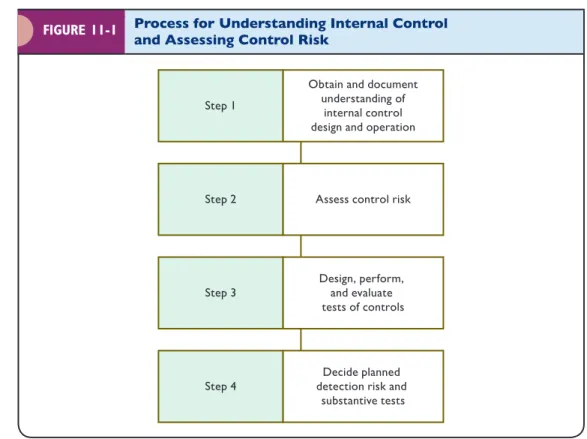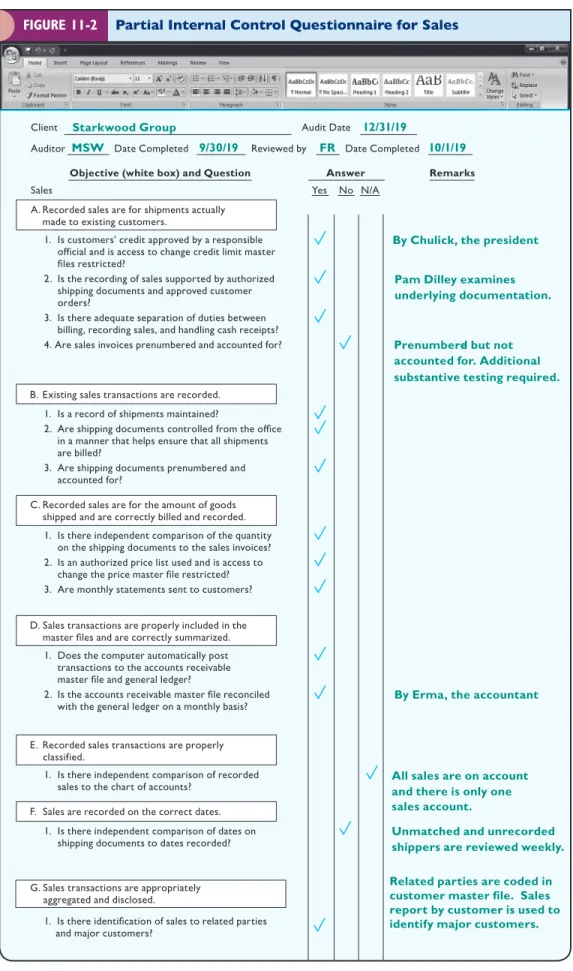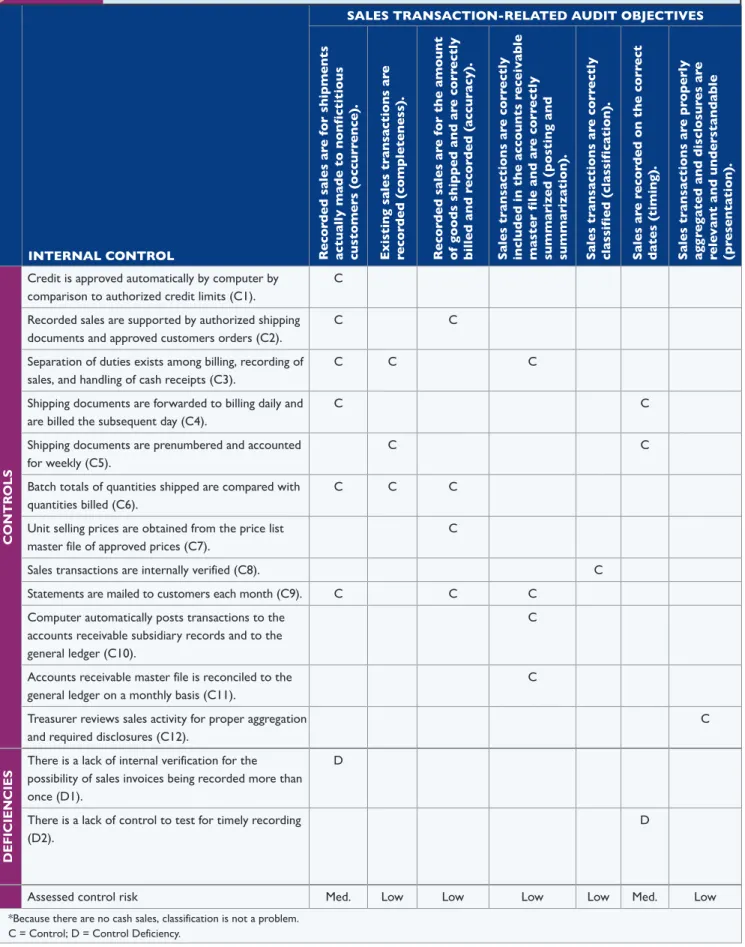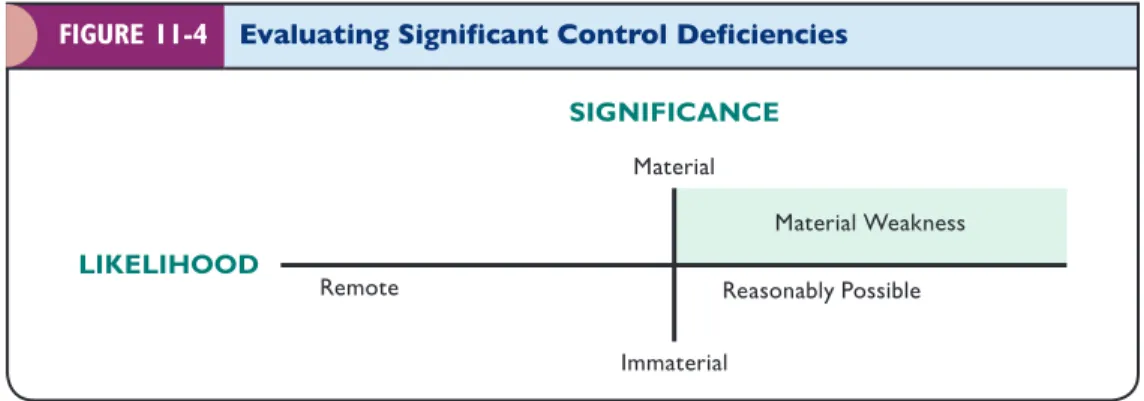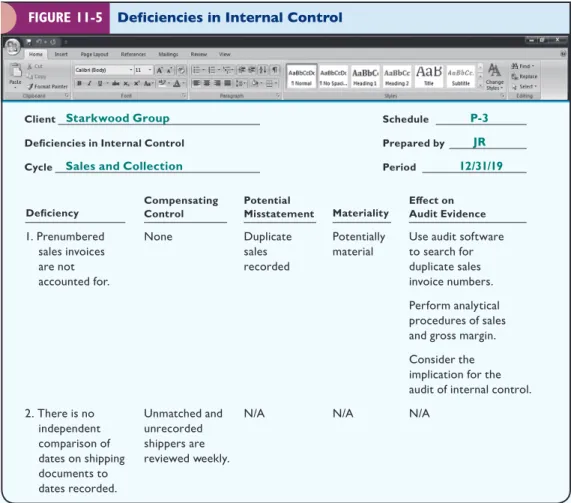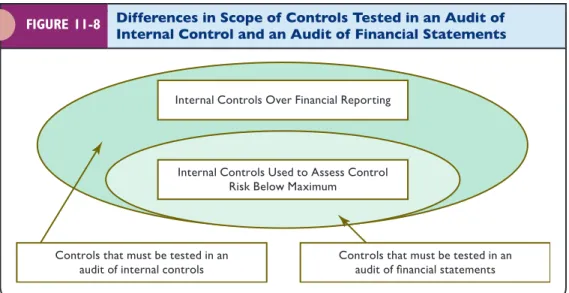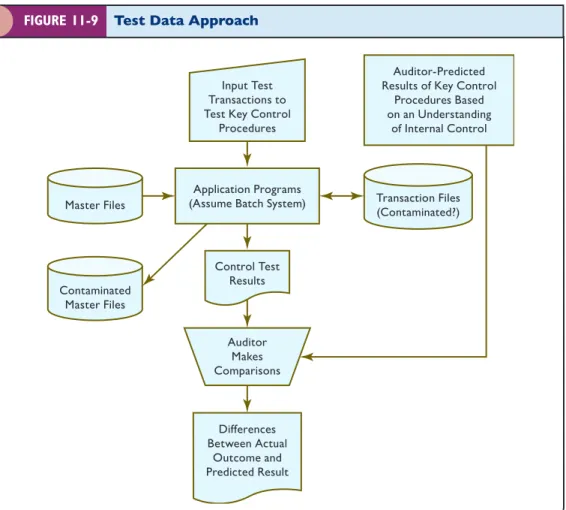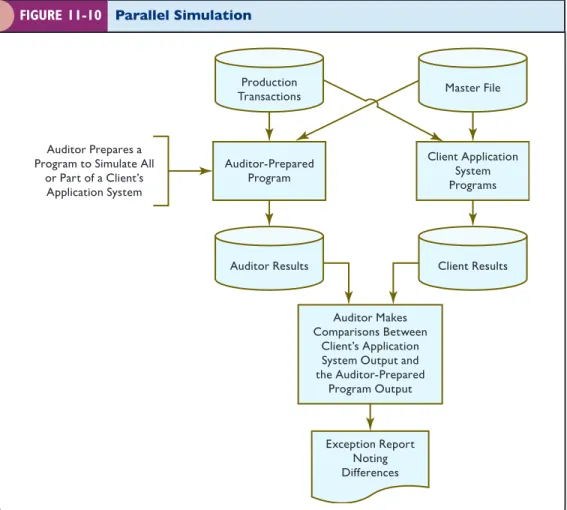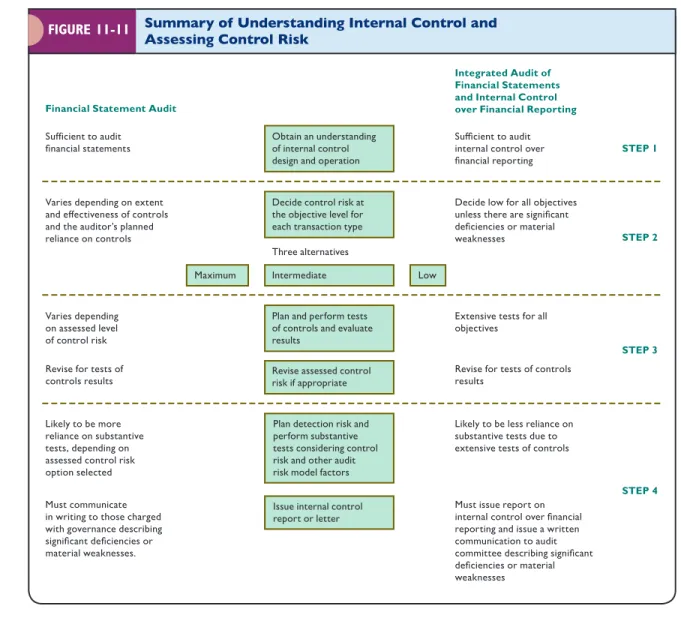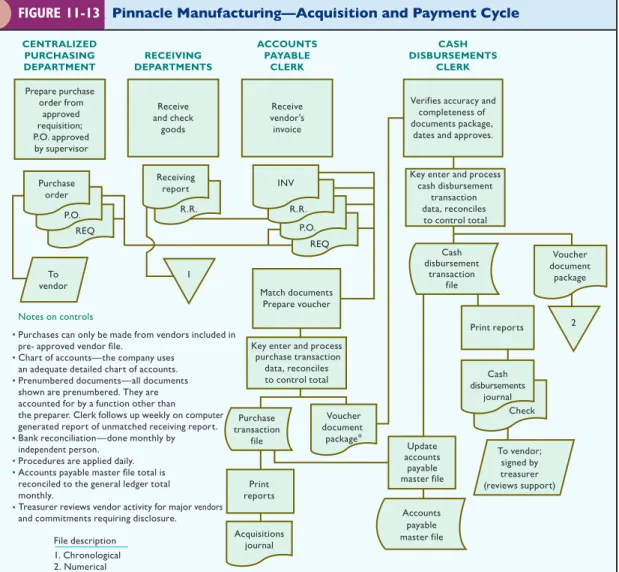LEARNING OBJECTIVES
After studying this chapter, you should be able to
11-1 Obtain and document an understanding of internal control.
11-2 Assess control risk by linking key controls and control deficiencies to transaction- related audit objectives.
11-3 Describe the process of designing and performing tests of controls.
11-4 Understand how control risk impacts detection risk and the design of substantive tests.
11-5 Understand requirements for auditor reporting on internal control.
11-6 Describe the differences in evaluating, reporting, and testing internal control for nonpublic and smaller public companies.
11-7 Describe how the complexity of the IT environment impacts control risk assessment and testing.
ASSESSING CONTROL RISK AND REPORTING
ON INTERNAL CONTROLS 11CHAPTER
Just Because a Computer Did the Work Doesn’t Mean it’s Right Allen, a senior auditor, is assigned to audit a subsidiary of Robot Banks, a UK-based financial institution, in Singapore. Robot recently merged with the Singapore subsidiary of Apache Banks, another UK-based financial institution, and decided to roll out a new system to consolidate all loan data onto one database.
During the audit planning phase, Allen overhead a conversation between two employees in Robot’s office cafeteria. “How was your weekend?,” one guy asked the other. “Terrible. I had to come in during the week- end to perform reconcilia- tions between the old and the new trade systems. The worst thing is that nobody knows why some figures were not captured in the new system.
There definitely are a lot of issues!”
“Oh no,” Allen thought to himself, “the audit on the rev- enue recognition of loans will have to be tested extensively.”
Normally, the merger of two subsidiaries would mean more extensive testing of account balances. With the rolling out of a new system, Allan would not only have to ramp up the number of audit tests, but will also be unable to rely on the data generated by the computer system. He would have to go back to the source documentation to perform his audit tests. “At least all the data from Robot is fully electronic, so I can perform audit analytics on the data from the two original systems,” Allen thought to himself. “Because audit analytics means I don’t have to select samples above a pre- determined amount, I can review all transactions and weed out the ‘odd’ transactions. I’ll then look into those ‘odd’ transactions. It’ll be a little like putting students to a common test. For those who pass, no further work is needed. For those who fail, more probing will be needed to understand why they failed and how they can pass in the future.”
I
n the previous chapter, we discussed the components of the COSO internal control framework and how compa- nies integrate technology into their system of internal control. In this chapter, we discuss how auditors obtain and document their understanding of internal control and assess control risk as part of the audit planning process.The opening story about GCC illustrates the risks arising from inadequate separation of duties, as well as lack of approvals and reconciliations.
OBTAIN AND DOCUMENT UNDERSTANDING OF INTERNAL CONTROL
Identify significant risks due to fraud or error
Finalize overall audit strategy and audit plan Understand internal control
and assess control risk Assess inherent risk Accept client and perform
initial audit planning
Set preliminary judgment of materiality and performance materiality
Perform preliminary analytical procedures Understand the client’s
business and industry
OBJECTIVE 11-1
Obtain and document an understanding of internal control.
For financial statement audits, auditors need to understand the design and implemen- tation of controls that are relevant to the audit to identify and assess the risks of mate- rial misstatements. For integrated audits of large, publicly traded companies, the level of understanding of internal control and the extent of testing need to be sufficient to issue an opinion on the effectiveness of internal control over financial reporting in addition to assessing the risks of material misstatement as part of the audit planning process. Thus, the level of understanding required for the audit of internal control ex- ceeds what is required for an audit of only the financial statements.
Figure 11-1 provides an overview of the process of understanding internal control and assessing control risk. The figure shows that there are four steps in the process.
Each of these four steps is discussed in this chapter.
Obtain and Document Understanding of Internal Control Design
Auditing standards require auditors to obtain and document their understanding of internal control for every audit. Evaluating the design of a control involves considering whether the control, either individually or in combination with other controls, is effective in preventing or detecting and correcting material misstatements. Management’s documentation is often a major source of information in gaining an understanding of the design of controls.
As part of the auditor’s risk assessment procedures, the auditor uses procedures to obtain an understanding, which involve gathering evidence about the design of internal
Obtain and document understanding of
internal control design and operation Step 1
Assess control risk Step 2
Design, perform, and evaluate tests of controls Step 3
Decide planned detection risk and
substantive tests Step 4
FIGURE 11-1 Process for Understanding Internal Control and Assessing Control Risk
controls and whether they have been implemented, and then using that information as a basis for assessing control risk and for the integrated audit. The auditor generally uses four of the eight types of evidence described in Chapter 6 to obtain an understanding of the design and implementation of controls: inspection, inquiry of entity personnel, observation of employees performing control processes, and reperformance by tracing one or a few transactions through the accounting system from start to finish.
Auditors commonly use three types of documents to obtain and document their understanding of the design of internal control: narratives, flowcharts, and internal control questionnaires. Because Section 404 of the Sarbanes–Oxley Act requires man- agement to assess and document the design effectiveness of internal control over fi- nancial reporting, they have usually already prepared this documentation. Narratives, flowcharts, and internal control questionnaires, used by the auditor separately or in combination to document internal control, are discussed next.
Narrative A narrative is a written description of a client’s internal controls. A proper narrative of an accounting system and related controls describes four things:
1. The origin of every document and record in the system. For example, the description should state where customer orders come from and how sales invoices are generated.
2. All processing that takes place. For example, if sales amounts are determined by a computer program that multiplies quantities shipped by standard prices con- tained in price master files, that process should be described.
3. The disposition of every document and record in the system. The filing or electronic archiving of documents, sending them to customers, or destroying them should be described.
4. An indication of the controls relevant to the assessment of control risk. These typically include separation of duties (such as separating recording cash from handling cash), authorizations and approvals (such as credit approvals), and internal verifi- cation (such as comparison of unit selling prices to sales contracts).
Flowchart An internal control flowchart is a diagram of the client’s documents and their sequential flow in the organization. An adequate flowchart includes the same four characteristics identified for narratives.
Well-prepared flowcharts are advantageous primarily because they provide a con- cise overview of the client’s system, including separation of duties, which helps au- ditors identify controls and deficiencies in the client’s system. Flowcharts have two advantages over narratives: typically they are easier to read and easier to update. It is unusual to use both a narrative and a flowchart to describe the same system because both present the same information. For an example of a flowchart, see Figure 11-13 (p. 373) for the Pinnacle Manufacturing integrated case problem.
Internal Control Questionnaire An internal control questionnaire asks a series of questions about the controls in each audit area as a means of identifying internal control deficiencies. Most questionnaires require a “yes” or a “no” response, with “no”
responses indicating potential internal control deficiencies. By using a questionnaire, auditors cover each audit area reasonably quickly. The two main disadvantages of questionnaires are their inability to provide an overview of the system and their inap- plicability for some audits, especially smaller ones.
Figure 11-2 (p. 338) illustrates part of an internal control questionnaire for the sales and collection cycle of Starkwood Group. Notice how the questionnaire incorporates the seven transaction-related audit objectives A through G as each applies to sales trans- actions (see shaded portions). The same is true for all other audit areas.
These methods are also used to obtain an understanding of IT general controls. The auditor interviews IT personnel and key users; examines system documentation such as flowcharts, user manuals, program change requests, and system testing results; and reviews detailed questionnaires completed by IT staff. In most cases, auditors should use several of these approaches in understanding general controls because each offers different information. For example, interviews with the chief information officer and
Obtain and document understanding of
internal control design and operation
Assess control risk Design, perform,
and evaluate tests of controls
Decide planned detection risk and
substantive tests
Client Audit Date
Auditor Date Completed
Objective (white box) and Question Answer Remarks Yes No N/A
Reviewed by Date Completed
Sales
A. Recorded sales are for shipments actually made to existing customers.
B. Existing sales transactions are recorded.
C. Recorded sales are for the amount of goods shipped and are correctly billed and recorded.
E. Recorded sales transactions are properly classified.
F. Sales are recorded on the correct dates.
D. Sales transactions are properly included in the master files and are correctly summarized.
1. Is customers’ credit approved by a responsible official and is access to change credit limit master files restricted?
2. Is the recording of sales supported by authorized shipping documents and approved customer orders?
3. Is there adequate separation of duties between billing, recording sales, and handling cash receipts?
4. Are sales invoices prenumbered and accounted for?
1. Is a record of shipments maintained?
2. Are shipping documents controlled from the office in a manner that helps ensure that all shipments are billed?
3. Are shipping documents prenumbered and accounted for?
1. Is there independent comparison of the quantity on the shipping documents to the sales invoices?
2. Is an authorized price list used and is access to change the price master file restricted?
3. Are monthly statements sent to customers?
1. Does the computer automatically post transactions to the accounts receivable master file and general ledger?
2. Is the accounts receivable master file reconciled with the general ledger on a monthly basis?
1. Is there independent comparison of recorded sales to the chart of accounts?
1. Is there independent comparison of dates on shipping documents to dates recorded?
Prenumbered but not accounted for. Additional substantive testing required.
Pam Dilley examines underlying documentation.
By Chulick, the president
All sales are on account and there is only one sales account.
Unmatched and unrecorded shippers are reviewed weekly.
By Erma, the accountant 12/31/19
FR MSW
Starkwood Group
9/30/19 10/1/19
G. Sales transactions are appropriately aggregated and disclosed.
1. Is there identification of sales to related parties and major customers?
Related parties are coded in customer master file. Sales report by customer is used to identify major customers.
FIGURE 11-2 Partial Internal Control Questionnaire for Sales
systems analysts provide useful information about the operation of the entire IT func- tion, the extent of software development and hardware changes made to accounting application software, and an overview of any planned changes. Reviews of program change requests and system test results are useful to identify program changes in appli- cation software. Questionnaires help auditors identify specific internal controls.
The use of questionnaires and flowcharts together is useful for understanding the cli- ent’s internal control design and identifying internal controls and deficiencies. Flowcharts provide an overview of the system, while questionnaires offer useful checklists to remind the auditor of many different types of internal controls that should exist.
Evaluating Internal Control Implementation In addition to understanding the design of the internal controls, the auditor must also
evaluate whether the controls have been implemented. Implementation means that the controls exist and the entity is using them. Because it makes little sense to evaluate the implementation of a control that is not suitably designed, the design of a control is considered first. However, in practice, the understanding of the design and the imple- mentation are often done simultaneously.
Evaluating the implementation of a control is most commonly done by completing a system walkthrough. In a walkthrough, the auditor selects one or a few documents of a transaction type and traces them from initiation through the entire accounting process. At each stage of processing, the auditor makes inquiries, observes activities, and examines completed documents and records. Walkthroughs conveniently com- bine inquiry, inspection, and observation to assure that the controls designed by man- agement have been implemented.
Make Inquiries of Client Personnel Auditors should ask management and other personnel to explain their duties. Careful questioning of appropriate personnel helps auditors evaluate whether employees understand their duties and do what is described in the client’s control documentation.
Inspect Documents and Records The five components of internal control all involve the creation of many documents and records. By examining completed documents, records, and computer files, the auditor can evaluate whether information described in flowcharts, narratives, and questionnaires has been implemented.
Observe Entity Activities and Operations When auditors observe client personnel carrying out their normal accounting and control activities, including their prepara- tion of documents and records, it further improves the auditors’ understanding and knowledge that controls have been implemented.
OBJECTIVE 11-2
Assess control risk by linking key controls and control deficiencies to transaction- related audit objectives.
ASSESS CONTROL RISK
The auditor obtains an understanding of the design and implementation of internal control to make a preliminary assessment of control risk as part of the auditor’s over- all assessment of the risk of material misstatements. As described in Chapter 8, the auditor uses this preliminary assessment of control risk to plan the audit for each ma- terial class of transactions. However, in some instances the auditor may learn that the control deficiencies are so significant that the client’s financial statements may not be auditable. For example, if management lacks integrity or the accounting records are seriously deficient, most auditors will not accept the engagement.
Determine Assessed Control Risk Supported by the Understanding Obtained After obtaining an understanding of the design and implementation of internal con-
trol, the auditor makes a preliminary assessment of control risk as part of the au- ditor’s overall assessment of the risk of material misstatement. This assessment is a measure of the auditor’s expectation that internal controls will prevent material mis- statements from occurring or detect and correct them if they have occurred.
The starting point for most auditors is the assessment of entity-level controls. By their nature, entity-level controls, such as many of the elements contained in the con- trol environment, risk assessment, and monitoring components, have an overarching impact on most major types of transactions in each transaction cycle. For example, an ineffective board of directors or management’s failure to have any process to identify, assess, or manage key risks has the potential to undermine controls for most of the transaction-related audit objectives. Thus, auditors generally assess entity-level con- trols before assessing transaction-specific controls.
Similarly, auditors should evaluate the effectiveness of IT general controls before evaluating automated application controls or manual controls dependent on IT out- put. Ineffective general controls create the potential for material misstatements across all system applications, regardless of the quality of individual application controls.
For example, if the auditor observes that data files are inadequately safeguarded, the auditor may conclude that there is a significant risk of loss of data for every class of transaction that relies on that data to conduct application controls. On the other hand, if general controls are effective, the auditor may be able to place greater reliance on ap- plication controls whose functionality is dependent on IT.
Once auditors determine that entity-level controls, including general IT controls, are designed and placed in operation, they next make a preliminary assessment for each transaction-related audit objective for each major type of transaction in each transaction cycle. For example, in the sales and collection cycle, the types of trans- actions usually involve sales, sales returns and allowances, cash receipts, and the provision for and write-off of uncollectible accounts. The auditor also makes the pre- liminary assessment for controls affecting audit objectives for balance sheet accounts, including presentation and disclosure, in each cycle.
Use of a Control Risk Matrix to Assess Control Risk
Many auditors use a control risk matrix to assist in the control risk assessment process at the transaction level. The purpose is to provide a convenient way to or- ganize assessing control risk for each audit objective. Figure 11-3 illustrates the use of a control risk matrix for sales transaction audit objectives of Starkwood Group.
While Figure 11-3 only illustrates the control risk matrix for transaction-related audit objectives, auditors use a similar control risk matrix format to assess control risk for balance-related audit objectives, including those related to presentation and disclo- sure. The control risk matrix can include both manual and automated application controls. We now discuss the preparation of the matrix.
Identify Audit Objectives The first step in the assessment is to identify the audit objectives for classes of transactions and account balances, including disclosures, to which the assessment applies. For example, this is done for classes of transactions by applying the specific transaction-related audit objectives introduced earlier, which were stated in general form, to each major type of transaction for the entity. For ex- ample, the auditor makes an assessment of the occurrence objective for sales and a separate assessment of the completeness objective. Transaction-related audit objec- tives are shown for sales transactions for Starkwood at the top of Figure 11-3.
Identify Existing Controls Next, the auditor uses the information discussed in the pre- vious section on obtaining and documenting an understanding of internal control to identify the controls that contribute to accomplishing transaction-related audit objec- tives. One way for the auditor to do this is to identify controls to satisfy each objective.
For example, the auditor can use knowledge of the client’s system to identify controls that are likely to prevent errors or fraud in the occurrence transaction-related audit objective.
The same thing can be done for all other objectives. It is also helpful for the auditor to use the five control activities (separation of duties, proper authorization, adequate docu- ments and records, physical control over assets and records, and independent checks on performance) as reminders of controls. For example: Is there adequate separation of
INTERNAL CONTROL
SALES TRANSACTION-RELATED AUDIT OBJECTIVES
Recorded sales are for shipments actually made to nonfictitious customers (occurrence). Existing sales transactions are recorded (completeness). Recorded sales are for the amount of goods shipped and are correctly billed and recorded (accuracy). Sales transactions are correctly included in the accounts receivable master file and are correctly summarized (posting and summarization). Sales transactions are correctly classified (classification). Sales are recorded on the correct dates (timing). Sales transactions are properly aggregated and disclosures are relevant and understandable (presentation).
CONTROLS
Credit is approved automatically by computer by comparison to authorized credit limits (C1).
C Recorded sales are supported by authorized shipping documents and approved customers orders (C2).
C C
Separation of duties exists among billing, recording of sales, and handling of cash receipts (C3).
C C C
Shipping documents are forwarded to billing daily and are billed the subsequent day (C4).
C C
Shipping documents are prenumbered and accounted for weekly (C5).
C C
Batch totals of quantities shipped are compared with quantities billed (C6).
C C C
Unit selling prices are obtained from the price list master file of approved prices (C7).
C
Sales transactions are internally verified (C8). C
Statements are mailed to customers each month (C9). C C C
Computer automatically posts transactions to the accounts receivable subsidiary records and to the general ledger (C10).
C
Accounts receivable master file is reconciled to the general ledger on a monthly basis (C11).
C Treasurer reviews sales activity for proper aggregation
and required disclosures (C12).
C
DEFICIENCIES
There is a lack of internal verification for the possibility of sales invoices being recorded more than once (D1).
D
There is a lack of control to test for timely recording (D2).
D
Assessed control risk Med. low low low low Med. low
*Because there are no cash sales, classification is not a problem.
C = Control; D = Control Deficiency.
Note: This matrix was developed using an internal control questionnaire, part of which is included in Figure 11-2 (p. 338), as well as flowcharts and other documen- tation of the auditor’s understanding of internal control.
FIGURE 11-3 Control Risk Matrix for Starkwood Group—Sales
SIGNIFICANCE
LIKELIHOOD
Material
Immaterial
Remote Reasonably Possible
Material Weakness
Source: Michael Ramos, “Section 404 Compliance in the Annual Report,” Journal of Accountancy, October 2004, pp. 43–48.
Copyright by American Institute of CpAs. All rights reserved. Used with permission.
FIGURE 11-4 Evaluating Significant Control Deficiencies
duties and how is it achieved? Are transactions properly authorized? Are prenumbered documents properly accounted for? Are key master files properly restricted from unau- thorized access? Is an independent verification of processes performed?
The auditor should identify and include only those controls that are expected to have the greatest effect on meeting the transaction-related audit objectives. These are often called key controls. The reason for including only key controls is that they will be sufficient to achieve the transaction-related audit objectives and also provide audit effi- ciency. Examples of key controls for Starkwood are shown in Figure 11-3 (p. 341).
Associate Controls With Related Audit Objectives Each control satisfies one or more related audit objectives. This can be seen in Figure 11-3 for transaction-related audit objectives. The body of the matrix is used to show how each control contributes to the accomplishment of one or more transaction-related audit objectives. In this il- lustration, a C was entered in each cell where a control partially or fully satisfied an objective. For example, sending statements to customers satisfies three objectives in the audit of Starkwood, which is indicated by the placement of a C on the row in Figure 11-3 describing that control.
Identify and Evaluate Control Deficiencies, Significant Deficiencies, and Material Weaknesses Auditors must evaluate whether key controls are absent in the design and implementation of internal control over financial reporting as a part of evaluating control risk and the likelihood of financial statement misstatements. Auditing stan- dards define three levels of the absence of internal controls:
1. Control deficiency. A control deficiency exists if the design or operation of con- trols does not permit management or employees, in the normal course of per- forming their assigned functions, to prevent, or detect and correct, misstatements on a timely basis. A design deficiency exists if a necessary control is missing, is not properly designed, or is not properly implemented. An operation deficiency exists if a well-designed control does not operate as designed or if the person performing the control is insufficiently qualified or authorized.
2. Significant deficiency. A significant deficiency is a deficiency, or a combination of deficiencies, in internal control over financial reporting that is less severe than a material weakness (defined next) yet important enough to merit attention by those charged with governance.
3. Material weakness. A material weakness is a deficiency, or combination of defi- ciencies, in internal control over financial reporting, such that there is a reason- able possibility that a material misstatement will not be prevented, or detected and corrected, on a timely basis.
To determine whether a significant internal control deficiency or deficiencies are a material weakness, they must be evaluated along two dimensions: likelihood and sig- nificance. The horizontal line in Figure 11-4 depicts the likelihood of a misstatement
Obtain and document understanding of
internal control design and operation
Assess control risk Design, perform,
and evaluate tests of controls
Decide planned detection risk and
substantive tests
resulting from the significant deficiency, while the vertical line depicts its significance.
If there is more than a reasonable possibility (likelihood) that a material misstatement (significance) could result from the significant deficiency or deficiencies, then it is considered a material weakness.
Identify Deficiencies, Significant Deficiencies, and Material Weaknesses A five-step approach can be used to identify deficiencies, significant deficiencies, and
material weaknesses:
1. Identify existing controls. Because deficiencies and material weaknesses are the ab- sence of adequate controls, the auditor must first know which controls exist. The methods for identifying controls have already been discussed.
2. Identify the absence of key controls. Internal control questionnaires, flowcharts, and walkthroughs are useful tools to identify where controls are lacking and the likeli- hood of misstatement is therefore increased. It is also useful to examine the con- trol risk matrix, such as the one in Figure 11-3, to look for objectives where there are no or only a few controls to prevent or detect misstatements.
3. Consider the possibility of compensating controls. A compensating control is one elsewhere in the system that offsets the absence of a key control. A common exam- ple in a small business is the active involvement of the owner. When a compensat- ing control exists, there is no longer a significant deficiency or material weakness.
4. Decide whether there is a significant deficiency or material weakness. The likelihood of misstatements and their potential materiality are used to evaluate whether there are significant deficiencies or material weaknesses.
5. Determine potential misstatements that could result. This step is intended to identify specific misstatements that are likely to result because of the significant defi- ciency or material weakness. The importance of a significant deficiency or ma- terial weakness is directly related to the likelihood and materiality of potential misstatements.
Figure 11-5 (p. 344) for Starkwood includes two control deficiencies. Neither deficiency was considered a material weakness; the first weakness, which is related to prenumbered sales invoices, was considered a significant deficiency.
Associate Control Deficiencies With Related Audit Objectives The same as for controls, each significant deficiency or material weakness can apply to one or more related audit objectives. In the case of Starkwood in Figure 11-3, there are two control deficiencies, and each applies to only one transaction-related objective. The control deficiencies are indicated in the body of the figure by a D in the appropriate objective column.
Assess Control Risk for Each Related Audit Objective After controls and control deficiencies are identified and associated with transaction-related audit objectives, the auditor can assess control risk for transaction-related audit objectives. This is the critical decision in the evaluation of internal control. The auditor uses all of the in- formation discussed previously to make a subjective control risk assessment for each objective. There are different ways to express this assessment. Some auditors use a subjective expression such as high, moderate, or low. Others use numerical probabili- ties such as 1.0, 0.6, or 0.2.
Again, the control risk matrix is a useful tool for making the assessment. Refer- ring to Figure 11-3 (p. 341), the auditor assessed control risk for each objective for Starkwood’s sales by reviewing each column for pertinent controls and control defi- ciencies and asking, “What is the likelihood that a material misstatement would not be prevented or detected, or corrected if it occurred, by these controls, and what is the effect of the deficiencies or weaknesses?” If the likelihood is low, then control risk is low, and so forth. Figure 11-3 for Starkwood shows that all objectives are assessed as low except occurrence and timing, which are medium.
TESTS OF CONTROLS
We’ve examined how auditors link controls and control deficiencies to related audit objectives to assess control risk for each objective. Now we’ll address how auditors test those controls that are used to support a control risk assessment. For example, each key control in Figure 11-3 that the auditor intends to rely on to support a control risk below the maximum must be supported by sufficient tests of controls. We will deal with tests of controls for both audits of internal control over financial reporting and audits of financial statements.
OBJECTIVE 11-3
Describe the process of de- signing and performing tests of controls.
This assessment is not the final one. Before making the final assessment at the end of an audit, the auditor will test controls and perform substantive tests. These pro- cedures can either support the preliminary assessment or cause the auditor to make changes. In some cases, management can correct deficiencies and material weak- nesses before the auditor does significant testing, which may permit a reduction in control risk.
After a preliminary assessment of control risk is made for sales and cash receipts, the auditor can complete the three control-risk rows of the evidence-planning work- sheet that was introduced in Chapter 8 on page 255. If tests of controls results do not support the preliminary assessment of control risk, the auditor must modify the worksheet later. Alternatively, the auditor can wait until tests of controls are done to complete the three control-risk rows of the worksheet. An evidence-planning work- sheet for Starkwood with the three rows for control risk completed is illustrated in Figure 14-6 on page 470.
1. Prenumbered sales invoices are not accounted for.
2. There is no independent comparison of dates on shipping documents to dates recorded.
None
Unmatched and unrecorded shippers are reviewed weekly.
Duplicate sales recorded
N/A
Potentially material
N/A
Use audit software to search for duplicate sales invoice numbers.
Perform analytical procedures of sales and gross margin.
Consider the implication for the audit of internal control.
N/A Client
Deficiencies in Internal Control Cycle
Schedule Prepared by Period
Potential
Misstatement Materiality Deficiency Compensating
Control
Effect on Audit Evidence
12/31/19 P-3
JR Starkwood Group
Sales and Collection
FIGURE 11-5 Deficiencies in Internal Control
Purpose of Tests of Controls Assessing control risk requires the auditor to consider the design, implementation,
and operation of controls to evaluate whether they will likely be effective in meeting related audit objectives. During the understanding phase, the auditor will have already gathered some evidence in support of both the design of the controls and their im- plementation by using procedures to obtain an understanding (see pages 336–339).
In most cases, the auditor will not have gathered enough evidence to reduce assessed control risk to a sufficiently low level. The auditor must therefore obtain additional evidence about the operating effectiveness of controls throughout all, or at least most, of the period under audit. The procedures to test effectiveness of controls in support of a reduced assessed control risk are called tests of controls.
If the results of tests of controls support the design and operation of controls as ex- pected, the auditor uses the same assessed control risk as the preliminary assessment.
If, however, the tests of controls indicate that the controls did not operate effectively, the assessed control risk must be reconsidered. For example, the tests may indicate that the application of a control was curtailed midway through the year or that the person applying it made frequent misstatements. In such situations, the auditor uses a higher assessed control risk, unless compensating controls for the same related audit objectives are identified and found to be effective. For integrated audits, the auditor must also consider the impact of those controls that are not operating effectively on the auditor’s report on internal control.
Obtain and document understanding of
internal control design and operation
Assess control risk Design, perform,
and evaluate tests of controls
Decide planned detection risk and
substantive tests
Procedures for Tests of Controls The auditor is likely to use four types of procedures to support the operating effective-
ness of internal controls. Management’s testing of internal control will likely include the same types of procedures. The four types of procedures are as follows:
1. Make inquiries of appropriate client personnel. Although inquiry is not a highly reliable source of evidence about the effective operation of controls, it is still appropriate. For example, to determine that unauthorized personnel are denied access to computer files, the auditor may make inquiries of the person who controls the computer li- brary and of the person who controls online-access security-password assignments.
2. Examine documents, records, and reports. Many controls leave a clear trail of documentary evidence (both electronic and paper) that can be used to test controls. Suppose, for example, that when a customer order is received, it is used to create a customer sales order, which is approved for credit. (See the first and second key controls in Figure 11-3 on page 341.) Then the customer order is attached to the sales order as authorization for further processing.
The auditor can test the control by examining the documents to make sure that they are complete and properly matched and that required signatures or initials are present.
3. Observe control-related activities. Some controls do not leave an evidence trail, which means that it is not possible at a later date to examine evidence that the control was executed. For example, separation of duties relies on specific persons performing specific tasks, and there is typically no documentation of the separate performance. (See the third key control in Figure 11-3.) For controls that leave no documentary evidence, the auditor generally observes them being applied at vari- ous points during the year.
4. Reperform client procedures. There are also control-related activities for which there are related documents and records, but their content is insufficient for the auditor’s purpose of assessing whether controls are operating effectively. For ex- ample, assume that prices on sales invoices are obtained from the master price list, but no indication of the control is documented on the sales invoices. (See the seventh key control in Figure 11-3 (p. 341).) In these cases, it is common for the auditor to reperform the control activity to see whether the proper results were obtained. For this example, the auditor can reperform the procedure by tracing
Other Considerations
the sales prices to the authorized price list in effect at the date of the transaction.
If no misstatements are found, the auditor can conclude that the procedure is op- erating as intended.
Extent of Procedures The extent to which tests of controls are applied depends on the preliminary as- sessed control risk. If the auditor wants a lower assessed control risk, more exten- sive tests of controls are applied, in terms of both the number of controls tested and the extent of the tests for each control. For example, if the auditor wants to use a low assessed control risk, a larger sample size for inspection, observation, and reperformance procedures should be applied. The extent of testing also depends on whether the control is manual or automated, and the frequency of the opera- tion of the control.
Manual Versus Automated Controls For frequently occurring manual controls, the auditor will select a sample of transactions and test whether the control is op- erating effectively. Because manual controls are performed by people, they are al- ways subject to random error or manipulation. As an example, if the client manually compares a purchase order, receiving report, and vendor’s invoice before approving payment to a vendor, an auditor may select a sample of recorded purchases through- out the year and verify the documents were properly matched and approved for payment.
For automated controls, if the computer is programmed accurately and that program remains unchanged, automated controls will consistently perform as pro- grammed until the software application is changed. Using the purchases example, the matching of the purchase order, receiving report, and vendor’s invoice may be done automatically by the computer. As a result, when there are effective general IT controls and an automated application control, it may only be necessary to test one transac- tion to determine the automated control is performing effectively. The auditor will use one of several approaches to determine whether the design and implementation of automated controls are appropriate and that they are operating effectively. These ap- proaches are discussed later in the chapter when we discuss controls in more complex IT environments.
Some controls include automated and manual components. Continuing with the purchase example, the computer may generate an exception report of purchases with differences in quantities among the vendor’s invoice, receiving report, and purchase order. An employee will then investigate and resolve the difference. In this case, the exception report is an automated control and the investigation is a manual control.
When testing the effectiveness of this control, the auditor must test the effectiveness of both the manual and automated components.
Control Frequency Many manual and automated controls over transactions oper- ate frequently because most transactions occur multiple times each day. As noted previously, for recurring manual controls, the auditor will normally test a sample of transactions from throughout the year. However, some financial reporting controls operate on a weekly, monthly, or quarterly basis, and some only operate at the end of the fiscal year. For example, the accounts receivable subledger is usually reconciled monthly to the general ledger. The auditor will test year-end controls, and will test a sample of controls that operate quarterly or monthly.
In addition to considering control frequency and whether a control is manual or auto- mated, the auditor considers several other factors in determining the extent of control testing. These factors include whether evidence about the effectiveness of the control was obtained in a previous audit and whether the control relates to a significant risk, as well as the period covered by the control testing.
Reliance on Evidence From the Prior Year’s Audit Auditors may be able to rely on evidence about the operating effectiveness of controls obtained in prior audits. Such reliance on previously tested controls is more likely for automated controls and when the client has an effective control environment and general IT controls, as well as lim- ited changes in operations and personnel. Auditing standards require tests of a con- trol’s effectiveness at least every third year.
If the auditor determines that a key control, whether manual or automated, has been changed since it was last tested, the auditor should test it in the current year.
When there are a number of controls tested in prior audits that have not been changed, auditing standards require the auditor to test some of those controls each year to en- sure there is a rotation of controls tested throughout the 3-year period.
Testing of Controls Related to Significant Risks As described in Chapter 8, signifi- cant risks are those risks that the auditor believes require special audit consideration.
When the auditor’s risk assessment procedures identify significant risks, the auditor is required to test the operating effectiveness of controls that mitigate these risks in the current-year audit, if the auditor plans to rely on those controls to support a control risk assessment below 100 percent. The greater the risk, the more audit evidence the auditor should obtain that controls are operating effectively.
Testing Less Than the Entire Audit Period Recall that management’s report on internal control deals with the effectiveness of internal controls as of the end of the fiscal year.
PCAOB auditing standards require the auditor to perform tests of controls that are ad- equate to determine whether controls are operating effectively at year end. The timing of the auditor’s tests of controls will therefore depend on the nature of the controls and when the company uses them. For controls that are applied throughout the accounting period, it is usually practical to test them at an interim date. The auditor will then deter- mine later whether changes in controls occurred in the period not tested and decide the implication of any change. Controls dealing with financial statement preparation occur only quarterly or at year end and must therefore also be tested at quarter end and year end.
Relationship Between Tests of Controls and Procedures to Obtain an Understanding There is a significant overlap between tests of controls and procedures to obtain an
understanding. Both include inquiry, inspection, and observation. There are two primary differences in the application of these common procedures.
Using Audit Software and Data Analytics to Perform Tests of Controls
The AICpA Guide to Data Analytics indicates that audit data analyt- ics (ADAs) can be used throughout the audit process, including tests of controls. However, the guide does not discuss the use of ADAs in performing tests of controls, and indicates more informa- tion is needed to develop guidance in this area.
As discussed in Chapter 10, auditors can already efficiently test many automated controls. However, audit software can also effectively test manual controls that are reflected in elec- tronic files. For example, a company may require the authorized department head to electronically approve each acquisition charged to their department. Audit software can be used to
identify whether there are any instances where a department acquisition lacked the appropriate approval. Of course, the audi- tor also needs to test computer access controls to verify that only department heads have approval access.
An audit data analytic performed as a test of details can also pro- vide evidence on the effectiveness of controls. Assume the client’s purchases system requires a three-way match of the quantities on the invoice, receiving report, and purchase order before an invoice is approved for payment. The auditor can use audit software to identify any acquisitions for which the three-way match criteria were not met. In addition to providing substantive evidence about the accuracy of purchase transactions, the test also identifies whether the client’s three-way match control was effective.
DATA ANALYTICS
1. In obtaining an understanding of internal control, the procedures to obtain an understanding are applied to all controls identified during that phase. Tests of controls, on the other hand, are applied only when the assessed control risk has not been satisfied by the procedures to obtain an understanding.
2. Procedures to obtain an understanding are performed only on one or a few trans- actions or, in the case of observations, at a single point in time. Tests of controls are performed on larger samples of transactions (perhaps 20 to 100), and observa- tions often are made at more than one point in time.
For key controls, tests of controls other than reperformance are essentially an exten- sion of procedures to obtain an understanding. Therefore, assuming the auditors plan to obtain a low assessed control risk from the beginning of the audit, they will likely com- bine both types of procedures and perform them simultaneously. Table 11-1 illustrates this concept in more detail. One option is to perform the audit procedures separately, as shown in Table 11-1, where minimum procedures to obtain an understanding of design and operation are performed, followed by additional tests of controls. An alternative is to combine both columns and do them simultaneously. The same amount of evidence is accumulated in the second approach, but more efficiently.
The determination of the appropriate sample size for tests of controls is an impor- tant audit decision. That topic is covered in Chapter 14.
Understanding Internal Controls in Outsourced Systems When clients use a ser- vice center for processing transactions, such as a payroll service provider or a broker for processing investment transactions, the auditor faces a difficulty when obtaining an understanding of the client’s internal controls for these transaction areas. Many of the controls reside at the service center, and the auditor cannot assume that the con- trols are adequate simply because it is an independent enterprise. Auditing standards require the auditor to consider the need to obtain an understanding and test the ser- vice center’s controls if the service center application involves processing significant financial data. For example, many of the controls for payroll transaction-related audit objectives reside within the software program maintained and supported by the pay- roll services company, not the audit client.
When obtaining an understanding of and testing the service center’s controls, the auditor should use the same criteria that was used in evaluating a client’s inter- nal controls. The depth of the auditor’s understanding depends on the complexity of the system and the extent to which the control is relied upon to reduce control risk.
The depth of understanding also depends on the extent to which key controls over transaction-related audit objectives reside at the service center for audits of internal control for public companies. If the auditor concludes that active involvement at the service center is the only way to conduct the audit, it may be necessary to obtain an
*Note: In an integrated audit for a public company, the auditor will likely combine procedures to obtain an understanding with tests of controls and perform them simultaneously.
Assessed Control Risk Type of Procedure High Level: Procedures to
Obtain an Understanding Lower Level: Tests of Controls*
Inquiry Yes—extensive Yes—some
Inspection Yes—with transaction walkthrough Yes—using sampling Observation Yes—with transaction walkthrough Yes—at multiple times
Reperformance No Yes—using sampling or audit
software TABLE 11-1 Relationship of Assessed Control Risk and
Extent of Procedures
understanding of internal controls at the service center and test controls using test data and other tests of controls.
Reliance on Service Center Auditors It has become increasingly common for service centers to engage a CPA firm to obtain an understanding and test internal controls of the service center (often referred to as “service organization controls” or “SOC”) and issue a SOC report for use by all customers and their independent auditors. The purpose of this in- dependent assessment is to provide service center customers reasonable assurance about the adequacy of the service center’s general and application controls and to eliminate the need for redundant audits by customers’ auditors. If the service center has many custom- ers and each requires an understanding of the service center’s internal control by its own independent auditor, the inconvenience and cost to the service center can be substantial.
Attestation standards provide guidance to auditors who issue reports on the inter- nal control of service organizations (service auditors), while auditing standards pro- vide guidance to auditors of user organizations (user auditors) that rely on the service auditor’s report. Service auditors may issue two types of reports:
• Report on management’s description of a service organization’s system and the suitability of the design of controls (referred to as a Type 1 report)
• Report on management’s description of a service organization’s system and the suitability of the design and operating effectiveness of controls (referred to as a Type 2 report)
A Type 1 report helps auditors obtain an understanding of internal control to plan the audit. However, auditors also require evidence about the operating effectiveness of controls to assess control risk, especially when auditing internal control over financial reporting for public companies. This evidence can
• be based on the service auditor’s Type 2 report, which includes tests of the oper- ating effectiveness of controls;
• come from tests of the user organization’s controls over the activities of the ser- vice organization;
• be created when the user auditor does appropriate tests at the service organization.
In October 2013, the pCAOB issued Staff Audit practice Alert No. 11, titled “Considerations for Audits of Internal Control over Financial Reporting,” highlighting common deficiencies re- lated to audits of internal control. However, even after the issuance of the practice alert, the audit of internal control over financial reporting continues to top the list of deficiencies identified in audits inspected by the pCAOB.
The pCAOB has commonly seen problems in three areas. The first is a failure to understand a company’s flow of transactions. As a result, auditors may not identify all the risks that exist, and controls selected for testing may not be responsive to the risk. Inspections commonly identified this problem in tests of revenue.
The second problem area involved management review controls, a detective control designed to identify error or fraud. To rely on a management review control, the auditor must understand the control and perform tests to evaluate whether it operates at a level of precision necessary to detect material misstatements. In some cases, the auditor
evaluated whether the control was performed but did not understand the information management examined in performing the control.
The third area is the testing of system-generated data or reports. If a control selected for testing relies on system-generated data or reports, the ef- fectiveness of the control depends in part on the controls over the accuracy and completeness of the system-generated information. For example, if the control relies on a price list in performing a test, the auditor needs to identify and test the controls over the accuracy and completeness of the price list.
To address these concerns, the pCAOB has a root cause initiative to understand factors that result in inspection findings. The pCAOB has found that things as simple as good project management skills contribute to a better quality audit.
Sources: 1. Speech by Helen Munter, “Importance of Audits of Internal Controls” (September 9, 2015); 2.
“Considerations for Audits of Internal Control over Financial Reporting,” pCAOB Audit practice Alert No. 11 (October 24, 2013) (pcaobus.org).
pCAOB IDeNTIFIeS DeFICIeNCIeS IN AUDITS OF INTeRNAl CONTROl OVeR FINANCIAl RepORTINg
We’ve focused on how auditors assess control risk for each related audit objective and support control risk assessments with tests of controls. The completion of these activities is sufficient for the audit of internal control over financial reporting, even though the report will not be finalized until the auditor completes the audit of finan- cial statements.
The auditor uses the control risk assessment and results of tests of controls to determine planned detection risk and related substantive tests for the audit of finan- cial statements. The auditor does this by linking the control risk assessments to the balance-related audit objectives, including disclosure, for the accounts affected by the major transaction types. The appropriate level of detection risk for each balance- related audit objective is then decided using the audit risk model. The relationship of transaction-related audit objectives to balance-related audit objectives and the selec- tion and design of audit procedures for substantive tests of financial statement bal- ances are discussed and illustrated in Chapter 12.
OBJECTIVE 11-5
Understand requirements for auditor reporting on internal control.
AUDITOR REPORTING ON INTERNAL CONTROL
As part of understanding internal control and assessing control risk, the auditor is re- quired to communicate certain matters to those charged with governance. This infor- mation and other recommendations about controls are also often communicated to management.
Communications to Those Charged With Governance and Management Letters
Communications to Those Charged With Governance The auditor must communi- cate significant deficiencies and material weaknesses in writing to those charged with governance as soon as the auditor becomes aware of their existence. The communication is usually addressed to the audit committee and to management. Timely communications may provide management an opportunity to address control deficiencies before manage- ment’s report on internal control must be issued. In some instances, deficiencies can be corrected sufficiently early such that both management and the auditor can conclude that controls are operating effectively as of the balance sheet date. For audits conducted under PCAOB standards, these communications must be made before the audit report on the financial statements is issued. For other audits, these communications must be made no later than 60 days following the audit report release. An example of a report used in the audit of a nonpublic company is provided in Figure 11-6.
If the user auditor decides to rely on the service auditor’s report, appropriate inquiries should be made about the service auditor’s reputation. Auditing standards state that the user auditor should not make reference to the report of the service auditor in the opinion on the user organization’s financial statements.
CONCEPT CHECK
1. Describe the four steps performed by the auditor when obtaining an understanding of internal control and assessing control risk.
2. What is the purpose of a control risk matrix?
3. What four types of procedures are used by auditors to test whether internal controls are operating effectively?
DECIDE PLANNED DETECTION RISK AND DESIGN SUBSTANTIVE TESTS
OBJECTIVE 11-4
Understand how control risk impacts detection risk and the design of substantive tests.
Obtain and document understanding of
internal control design and operation
Assess control risk Design, perform,
and evaluate tests of controls
Decide planned detection risk and
substantive tests
Management Letters In addition to these matters, auditors often identify less significant internal control–related issues, as well as opportunities for the client to make operational improvements. These should also be communicated to the client.
The form of communication is often a separate letter for that purpose, called a management letter. Although management letters are not required by auditing stan- dards, auditors generally prepare them as a value-added service of the audit.
Section 404 Reporting Requirements Based on the auditor’s assessment and testing of internal control, the auditor is re-
quired to prepare an audit report on internal control over financial reporting for accel- erated filer public companies subject to Section 404(b) reporting requirements. As we will describe in Chapter 24, the auditor may issue separate or combined audit reports on the financial statements and on internal control over financial reporting. An ex- ample of a separate report is illustrated in Figure 24-4 on page 761.
FIGURE 11-6 Letter Regarding Significant Deficiencies in Internal Control To Management and the Audit Committee
Airtight Machine Company
In planning and performing our audit of the financial statements of Airtight Machine Company as of and for the year ended December 31, 2019, in accordance with auditing standards generally accepted in the United States of America, we considered Airtight Machine Company’s internal control over financial reporting (internal control) as a basis for designing audit procedures that are appropriate in the circum- stances for the purpose of expressing our opinion on the financial statements, but not for the purpose of expressing an opinion on the e ctiveness of Airtight Machine Company’s internal control. Accordingly,
Our consideration of internal control was for the limited purpose described in the preceding paragraph and was not designed to identify all deficiencies in internal control that might be material weaknesses or significant deficiencies and therefore, material weaknesses or significant deficiencies may exist that were not identified. However, as discussed below, we identified certain deficiencies in internal control that we consider to be significant deficiencies.
A deficiency in internal control exists when the design or operation of a control does not allow manage- ment or employees, in the normal course of performing their assigned functions, to prevent, or detect and correct, misstatements on a timely basis. A material weakness is a deficiency, or combination of deficiencies, in internal control, such that there is a reasonable possibility that a material misstatement of the entity’s financial statements will not be prevented, or detected and corrected, on a timely basis. A significant deficiency is a deficiency or combination of deficiencies, in internal control, that is less severe than a material weakness, yet important enough to merit attention by those charged with governance.
We consider the following deficiency in the Company’s internal control to be a significant deficiency:
There is a lack of independent verification of the key entry of the customer’s name, product number, quantity shipped, prices used, and the related mathematical extensions on sales invoices and credit memos. As a consequence, errors in these activities could occur and remain uncorrected, adversely affecting both recorded net sales and accounts receivable. This deficiency is significant because of the large size of the average sale at Airtight Machine Company.
This communication is intended solely for the information and use of management and the board of directors and is not intended to be and should not be used by anyone other than these specified parties.
Very truly yours,
Johnson and Seygroves, CPAs
Troy, Michigan February 12, 2020 we do not express an opinion on the effectivenss of the company’s internal control.
ffe
